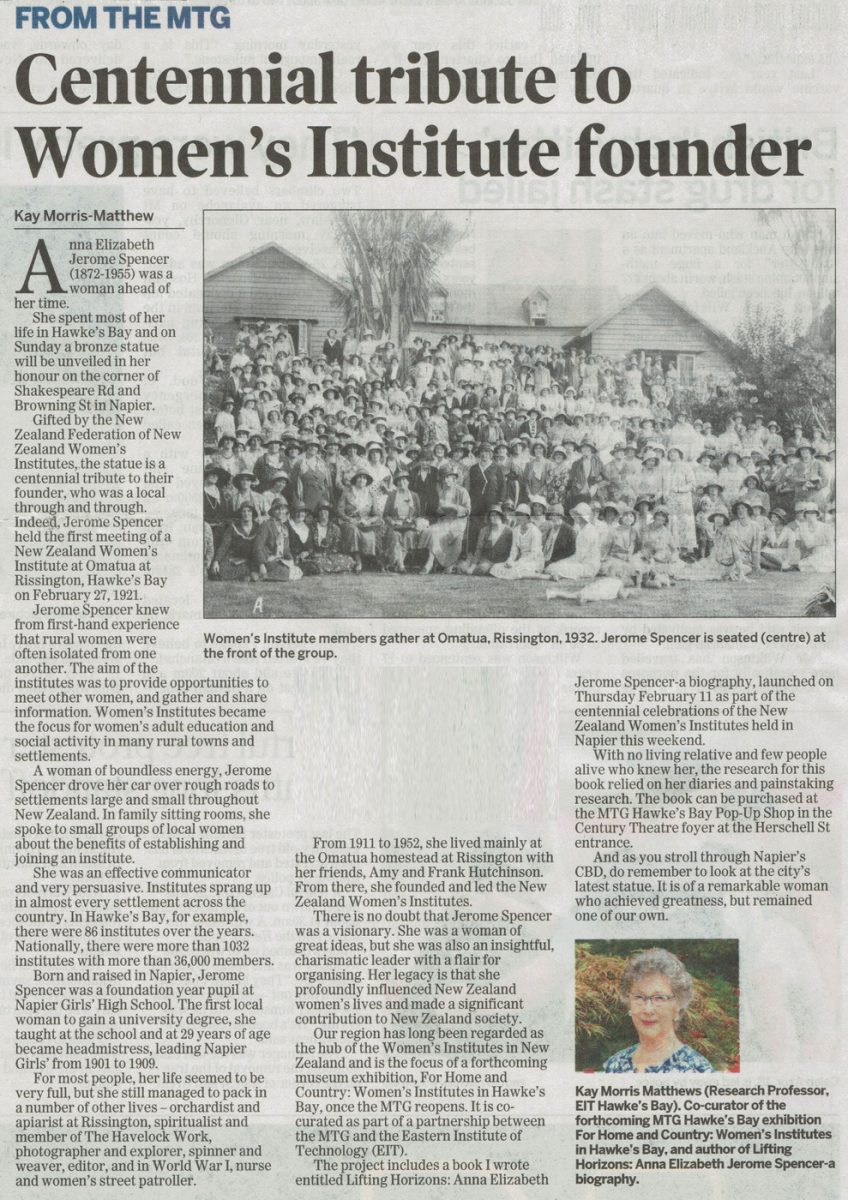FROM THE MTG
Centennial tribute to Women’s Institute founder
Kay Morris-Matthew [Morris Matthews]
Anna Elizabeth Jerome Spencer (1872-1955) was a woman ahead of her time.
She spent most of her life in Hawke’s Bay and on Sunday a bronze statue will be unveiled in her honour on the corner of Shakespeare Rd and Browning St in Napier.
Gifted by the New Zealand Federation of New Zealand Women’s Institutes, the statue is a centennial tribute to their founder, who was a local through and through. Indeed, Jerome Spencer held the first meeting of a New Zealand Women’s Institute at Omatua at Rissington, Hawke’s Bay on February 27, 1921.
Jerome Spencer knew from first-hand experience that rural women were often isolated from one another. The aim of the institutes was to provide opportunities to meet other women, and gather and share information. Women’s Institutes became the focus for women’s adult education and social activity in many rural towns and settlements.
A woman of boundless energy, Jerome Spencer drove her car over rough roads to settlements large and small throughout New Zealand. In family sitting rooms, she spoke to small groups of local women about the benefits of establishing and joining an institute.
She was an effective communicator and very persuasive. Institutes sprang up in almost every settlement across the country. In Hawke’s Bay, for example, there were 86 institutes over the years. Nationally, there were more than 1032 institutes with more than 36,000 members.
Born and raised in Napier, Jerome Spencer was a foundation year pupil at Napier Girls’ High School. The first local woman to gain a university degree, she taught at the school and at 29 years of age became headmistress, leading Napier Girls’ from 1901 to 1909.
For most people, her life seemed to be very full, but she still managed to pack in a number of other lives – orchardist and apiarist at Rissington, spiritualist and member of The Havelock Work, photographer and explorer, spinner and weaver, editor, and in World War I, nurse and women’s street patroller.
From 1911 to 1952, she lived mainly at the Omatua homestead at Rissington with her friends, Amy and Frank Hutchinson. From there, she founded and led the New Zealand Women’s Institutes.
There is no doubt that Jerome Spencer was a visionary. She was a woman of great ideas, but she was also an insightful, charismatic leader with a flair for organising. Her legacy is that she profoundly influenced New Zealand women’s lives and made a significant contribution to New Zealand society.
Our region has long been regarded as the hub of the Women’s Institutes in New Zealand and is the focus of a forthcoming museum exhibition, For Home and Country: Women’s Institutes in Hawke’s Bay, once the MTG [Museum Theatre Gallery] reopens. It is co-curated as part of a partnership between the MTG and the Eastern Institute of Technology (EIT).
The project includes a book I wrote entitled Lifting Horizons: Anna Elizabeth Jerome Spencer – a biography, launched on Thursday February 11 as part of the centennial celebrations of the New Zealand Women’s Institutes held in Napier this weekend.
With no living relative and few people alive who knew her, the research for this book relied on her diaries and painstaking research. The book can be purchased at the MTG Hawke’s Bay Pop-Up Shop in the Century Theatre foyer at the Herschell St entrance.
And as you stroll through Napier’s CBD, do remember to look at the city’s latest statue. It is of a remarkable woman who achieved greatness, but remained one of our own.
Photo captions –
Women’s Institute members gather at Omatua, Rissington, 1932. Jerome Spencer is seated (centre) at the front of the group.
Kay Morris Matthews (Research Professor, EIT Hawke’s Bay). Co-curator of the forthcoming MTG Hawke’s Bay exhibition For Home and Country: Women’s Institutes in Hawke’s Bay, and author of Lifting Horizons: Anna Elizabeth Jerome Spencer – a biography.












Do you know something about this record?
Please note we cannot verify the accuracy of any information posted by the community.